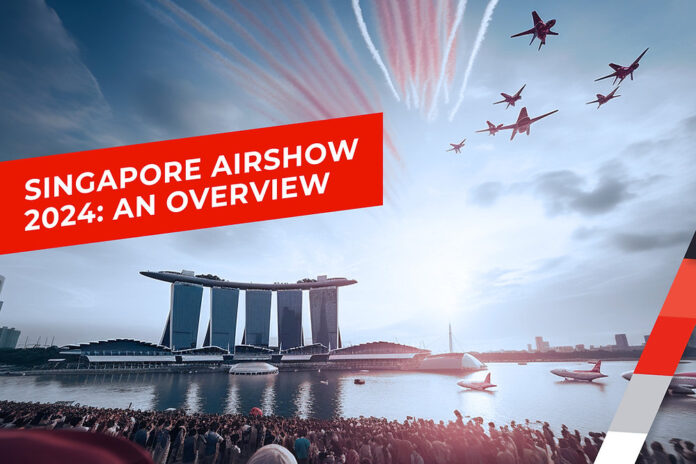
Sustainability continues to be the industry buzzword as the aviation sector pushes ahead to meet its 2050 net zero emissions target.
The International Air Transport Association (IATA) estimates that it will take up to USD 5.3 trillion AND a combination of measures including maximum elimination of emissions at the source, use of Sustainable Aviation Fuel (SAF), new technology, infrastructure and operational efficiencies as well as offsets and carbon capture to realize this goal over the next two plus decades.
These measures and more will be high on the agenda at Singapore Airshow 2024. The event’s thought leader AeroForum series will see discussions led by McKinsey and Company’s experts, while What’s Next@Airshow will feature innovations in this space by a selection of startups in partnership with accelerator Starburst.
Sustainability at the core of the Airshow
IATA estimates that around 65% of the mitigation needed for net zero carbon emissions in 2050 will come from SAF. In 2022, global SAF production reached at least 300 million litres – a 200% increase on the 2021 production total of 100 million litres. According to IATA, governments will need to provide greater production incentives to ramp up the supply of SAF.
To move the conversation forward on SAF, the AeroForum discussion led by McKinsey & Company titled “Sustainable Aviation – Navigating Complexities and Crafting Winning Strategies”, will feature a panel comprising senior executives from the Civil Aviation Authority of Singapore, Airbus, Cathay Pacific Airways, EcoCeres Inc and FlyORO.
Panelists will identify the key factors critical to achieving sustainable aviation through the use of SAF, and focus on the challenges impeding wider SAF production such as cost, production, scalability, technology, feedstock availability, consumer behaviour. The need for industry wide co-operation in overcoming these challenges and the financial implications of SAF adoption, governmental subsidies, incentives and sourcing strategies will also be addressed.
To further the discussion on sustainable aviation, the Airshow will host a breakfast chat with Mr Han Kok Juan, Director-General of the Civil Aviation Authority of Singapore (CAAS), in collaboration with McKinsey and Company, to discuss the role the Asia Pacific region now plays in the development of sustainable innovations and solutions globally.
Innovation on show
Mr Leck Chet Lam, Managing Director of Experia, organiser of Singapore Airshow 2024 said, “We are cognizant that meeting the target of net zero carbon emissions by 2050 will require partnership and a concerted effort, involving the aviation industry, as well as new players in technology and innovation. As a leading global destination for industry dialogues and strategic collaborations, Singapore Airshow will provide a critical platform to achieving the industry’s collective goals in innovation and sustainability.”
New technology continues to be a mainstay at the Airshow. Both established aviation heavyweights and promising start-ups will showcase their innovative solutions at Singapore Airshow 2024.
“What’s Next@Singapore Airshow” will see 41 start-ups from 15 countries and regions including Australia, India, Netherlands, Singapore, Slovakia, Spain, the United States, and the United Kingdom showcasing their cutting-edge innovations, dual use technologies, air traffic management and digitalisation in aerospace and defence industries.
Building a pipeline of Talent
To keep pace with the anticipated growth of the commercial and private travel markets, the aviation industry will need to hire 1.3 million professionals by 2032 according to Canadian aviation training company CAE in its 2023 Aviation Talent Forecast report.
Overall, the civil aviation industry will need 284,000 new pilots, 402,000 new technicians and 599,000 cabin crew over the next 10 years as the number of aircraft in service grows.
To address this pressing need to developing a sustainable talent pool, the Airshow has also collaborated with educational institutions to showcase the sector’s best to students, who will make up its future talent pool. Approximately 3,000 students are expected to attend this year’s Airshow and benefit from the STEM (Science, Technology, Engineering and Mathematics) workshops by Rolls Royce; and Student Ambassador Programmes organised by the Bell, Civil Aviation Authority of Singapore, Hope Technik, Lufthansa Technik, Republic of Singapore Air Force, and Rolls Royce.
The Endeavor Space Challenge organised in collaboration with Science Centre Singapore and US-based Kallman Worldwide as well as the Innovation Hangar Challenge run in collaboration with Embry-Riddle Aeronautical University (ERAU) offers young aviation talents a chance to apply their imagination, creativity and intellect as they tap into the guidance and expertise of senior aviation and aerospace engineers.
Asia Pacific’s leading sustainable destination
While sustainability was top of mind in the content planning for the show – it will also be front and centre when it comes to the set up and management of the Airshow. For the first time, organisers have partnered with CarbonClick, to allow attendees to offset the carbon emissions associated with their travel via the purchase of carbon credits, which will go to support high-quality, fully certified climate projects such as the Rimba Raya biodiversity reserve in Indonesia and the wind power project in India.
In addition, the Changi Exhibition Centre that will house the Airshow will be powered by solar energy via its 15,000 solar roof panels and also a Sustainable Networking Zone where all its booths, furniture and fittings are manufactured using recycled waste materials. And for the first time, Hyundai’s fleet of IONIQ 5 electric vehicle will be deployed to transport Singapore Airshow’s VIP delegates.
Efforts such as these will also go a long way towards aligning with the Singapore Government’s efforts to developing Singapore as Asia Pacific’s leading sustainable MICE (Meetings, Incentives, Conferences, Exhibitions) destination by 2030.
